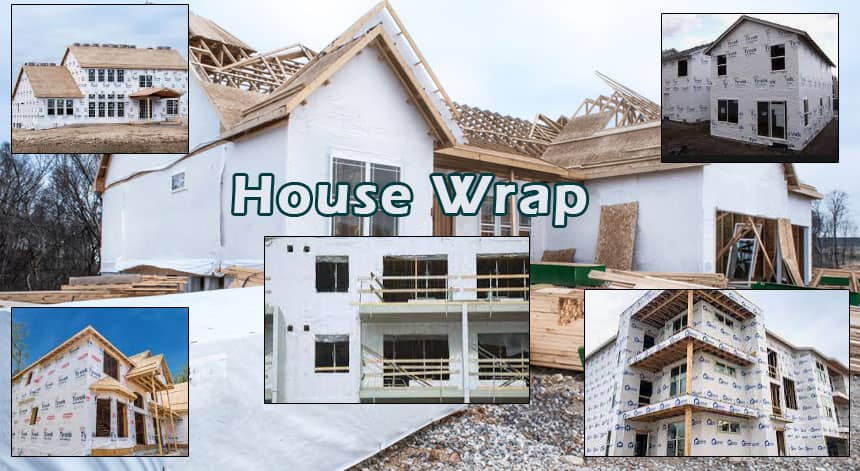House Wrap and its Importance in the Construction Industry

During home construction, house wrap is a common sight, but most people aren't sure why it's used. It helps improve your home's energy efficiency and boost its thermal efficiency by providing a simple air and moisture barrier. A house wrap is expansive, easy to apply, and improves building envelope efficiency.
Define House wrap
Synthetic materials are usually wrapped around plywood to form house wraps. Water cannot infiltrate into your inner wall assembly when you use house wrap. Because of its expansive nature, it can be applied quickly, overlapped, and sealed to improve the building envelope of your home.
Features of House wrap
- House wraps are designed to prevent moisture from entering the building cavity from the outside.
- The house wrap is not impermeable, unlike most WRBs. By doing so, moisture-laden air is allowed to enter the house instead of being trapped in the wall cavity. The only difference between a house wrap and a WRB is that a house wrap is a WRB and a WRB is not a house wrap.
- A house wrap resists air and water and allows water vapor to pass through. The fiber-spun technology imparts water and air resistance to the house wrap. The nonwoven fabrics provide strength to the house wrap. The fiber pores in the house wrap contribute to its breathability.
- In this case, a house wrap should be installed over the sheathing and behind the siding. Sidings such as wood, fiber, vinyl, brick, stucco, cement, and fiber cement can be used with it. Siding manufacturers usually specify what type of house wrap works best with their siding materials.
- Typically, house wraps are completed with cladding or sliding. In general, house wraps should be covered within 120 days of installation to prevent damage and leaks caused by UV rays. House wraps are more durable when they are covered immediately.
Installation of House Wrap
It is most likely that your contractor will be responsible for installing your house wrap unless you are building a home from scratch. Check that the house wrap is installed to the very top of the walls without visible gaps or spaces if you want to offer some oversight while the contractor is installing it. In addition, make sure that all edges and overlaps are sealed with high-quality building tape.
Types of House Wrap
Synthetic House Wrap
A synthetic or woven plastic house wrap is made up of long, slender threads that run in both directions. There used to be a lot of felt paper used in new home construction, though it is less common now. Tyvek, the most commonly used house wrap, is made from wet-laid polyethylene fibril nonwovens.
Spun-bond Non-oven
House wraps made of nonwoven materials: These wraps are made using short fibers and patterned randomly. This type of material is used in both CentraWrap and Typar house wraps. Water vapor is able to pass through this type of house wrap while preventing water infiltration. This type of wrap is generally the most stable to prevent long-term degradation.
Drainable House Wrap
Despite the wrap's design, water does not get trapped behind it. This will allow water to escape if it does infiltrate the wall system quickly.
Micro-perforated House Wrap
The purpose of these types of house wraps is to allow air to permeate the product in order to maintain a healthy respiratory rate for the home.
Purpose of House Wrap
The purpose of house wrap is to protect the wall frames of a building from external moisture penetration. In construction, a house wrap is a lightweight sheet installed behind a house's siding and sheathing to provide a water resistant barrier which is also known as WRB. House wraps for buildings have many important characteristics.
House Wrap Durability
The house wrap should last for as long as the house stands since it is covered by the exterior cladding. Prior to the installation of cladding, house wrap has a significant impact on durability. A house wrap's UV light resistance, tensile strength, cold resistance, and surfactant resistance determine its rating.
It is recommended to cover some house wraps within four months due to UV exposure. The sun and other elements can be exposed to others for nine months. House wrap can be prone to damage & leaks due to the high ultraviolet radiation.
Merits or Demerits of House Wrap
Infiltration of unwanted water into your home can be significantly reduced by the use of house wrap. It is possible for mold to grow on your interior walls as a result of this infiltration. Additionally, it can improve the energy efficiency and thermal performance of your home when installed correctly. If proper ventilation is not installed, house wrap and other air sealing techniques can result in reduced indoor air quality.
